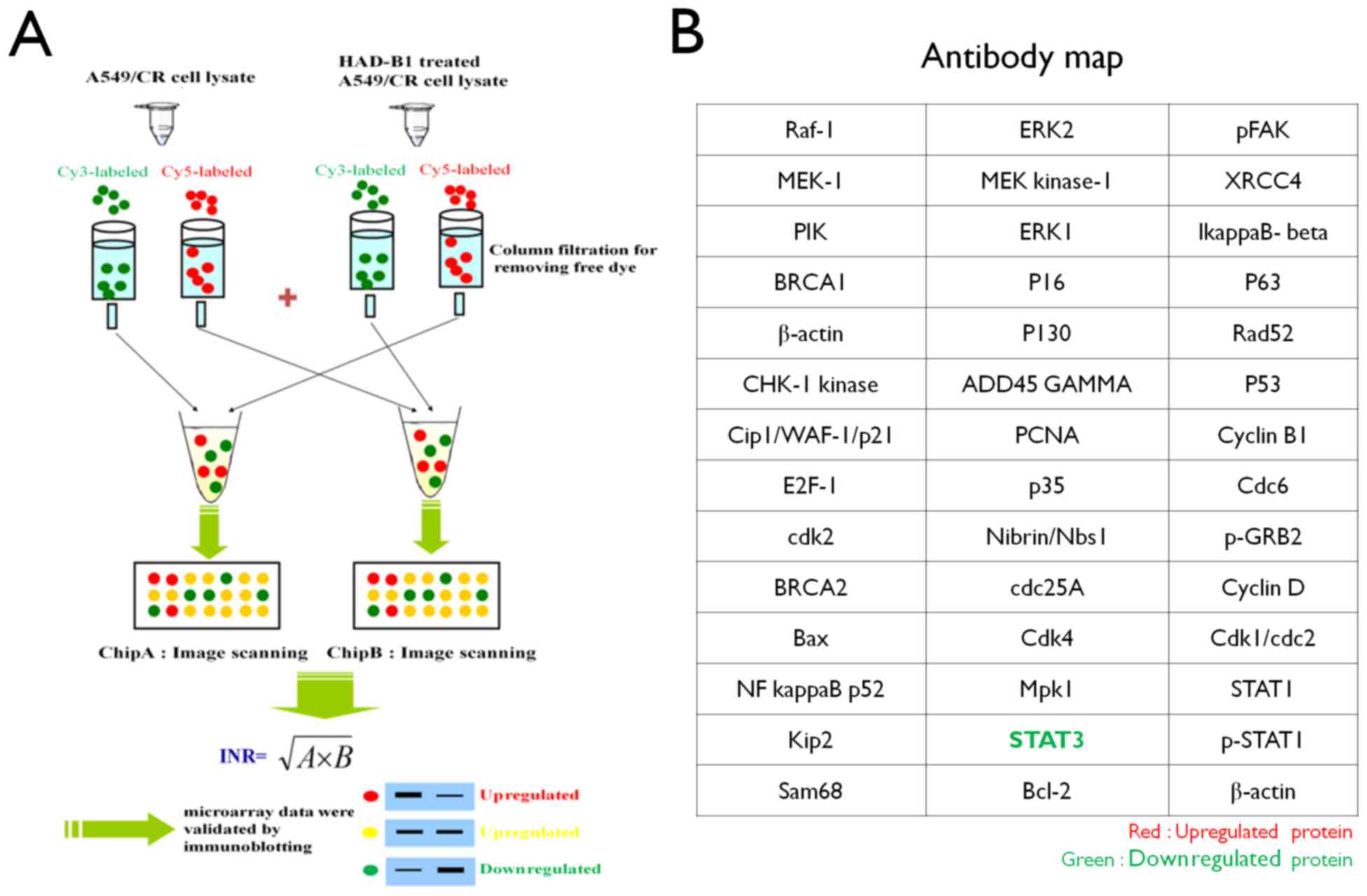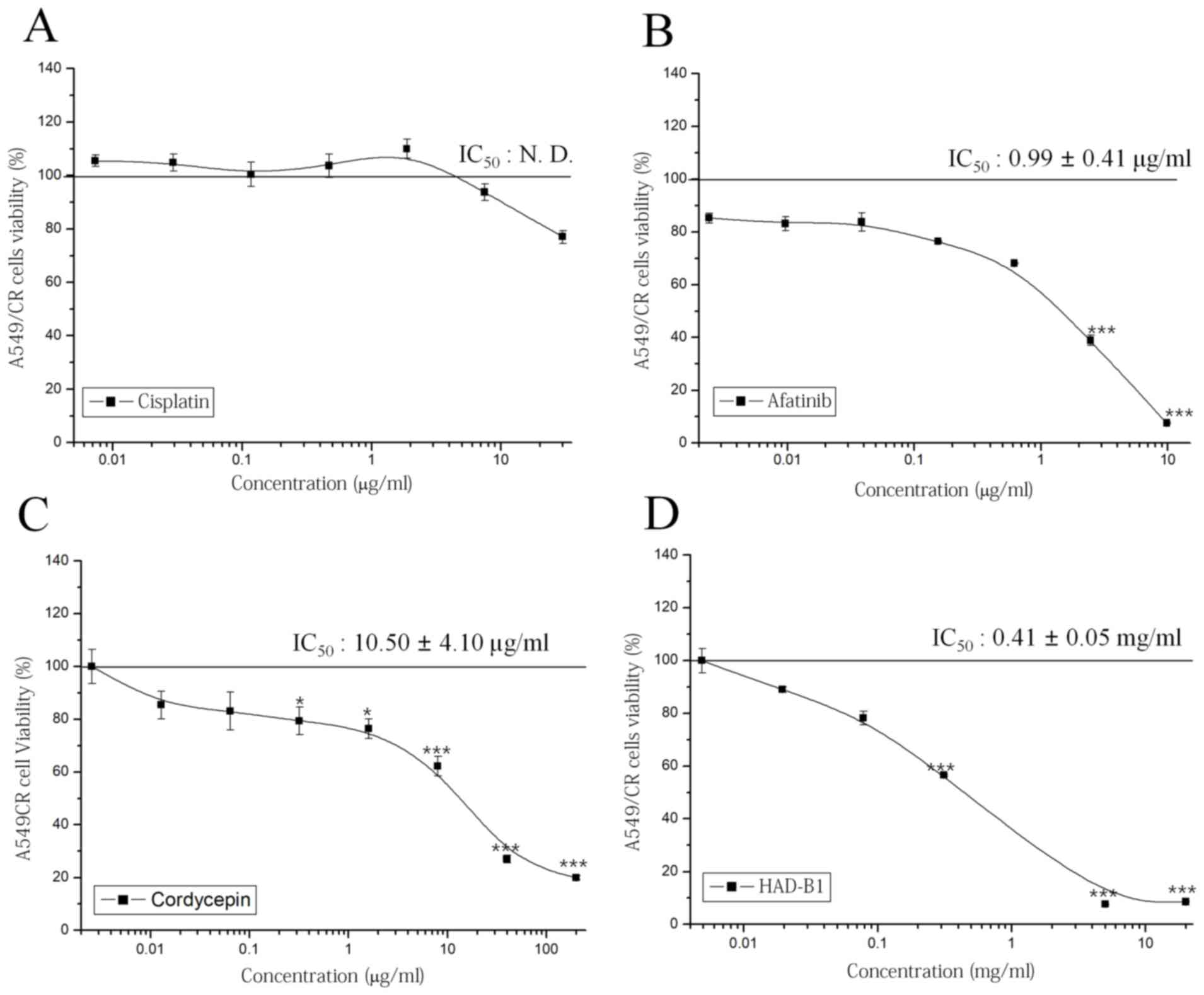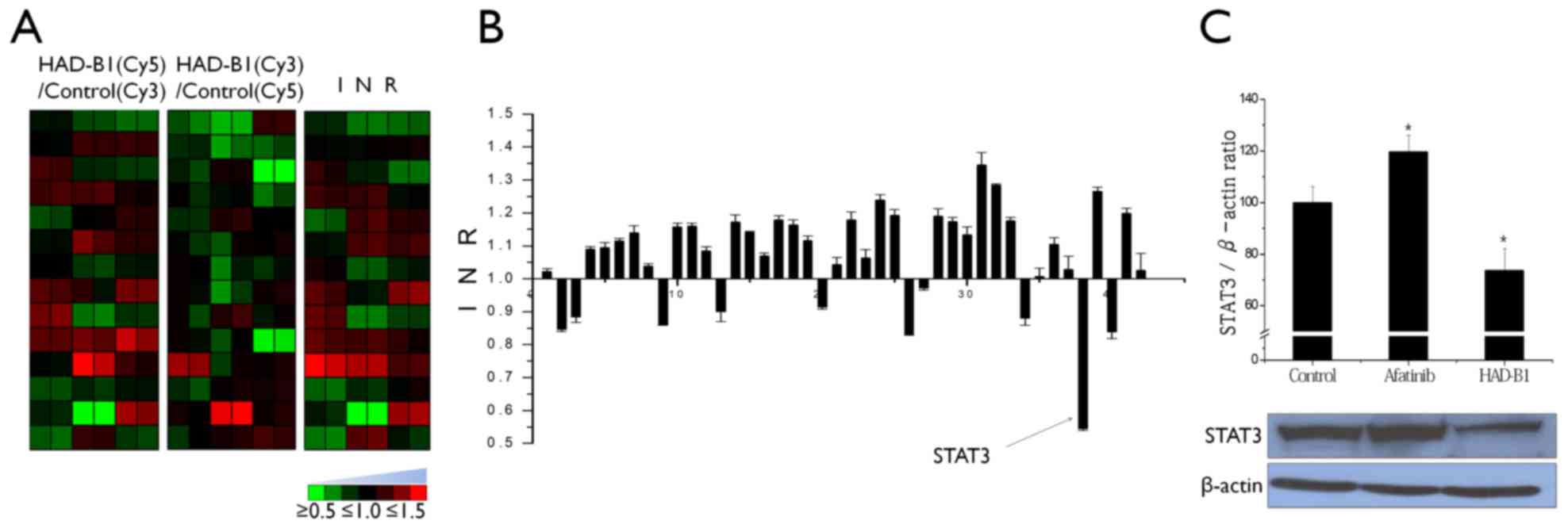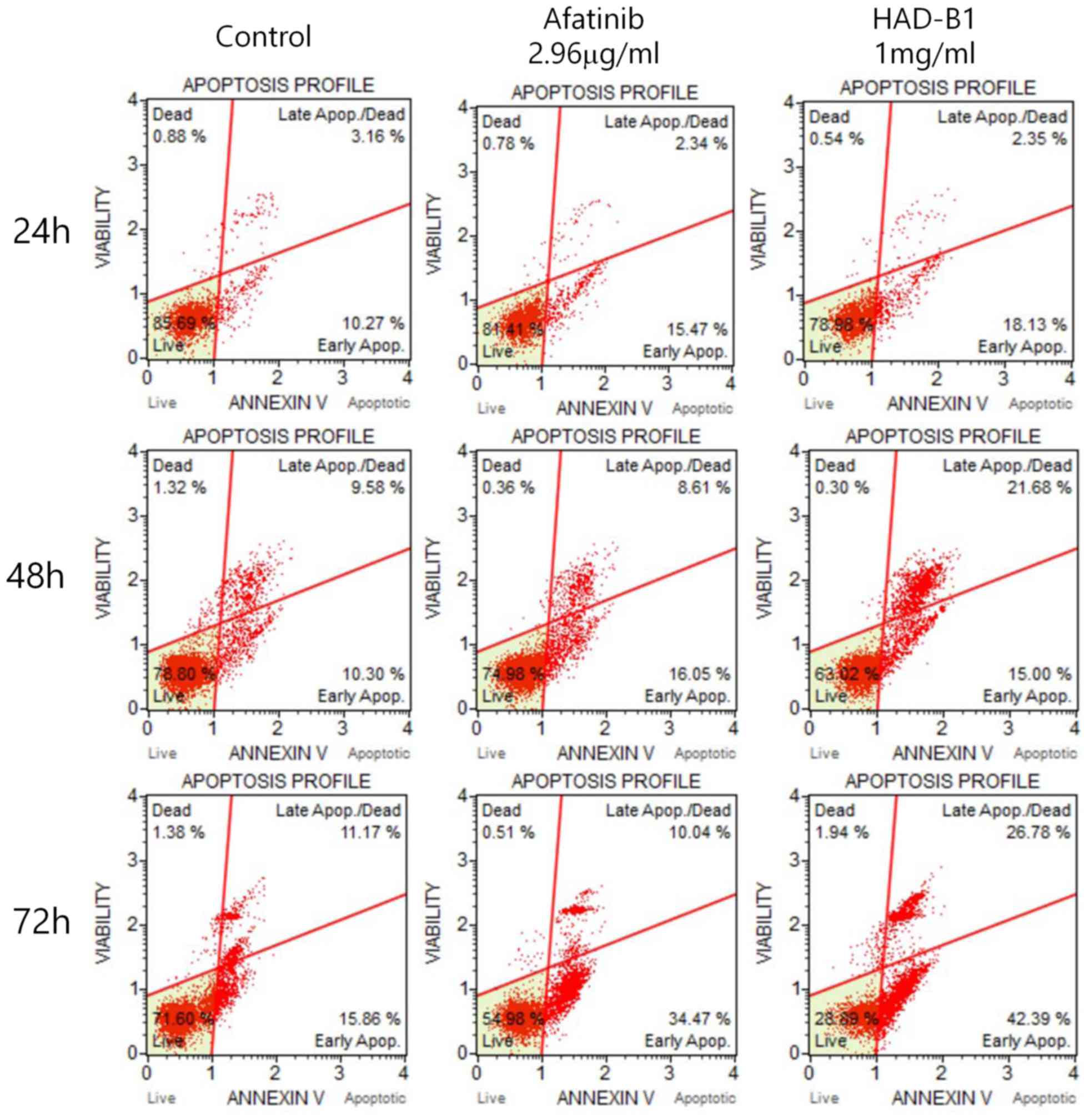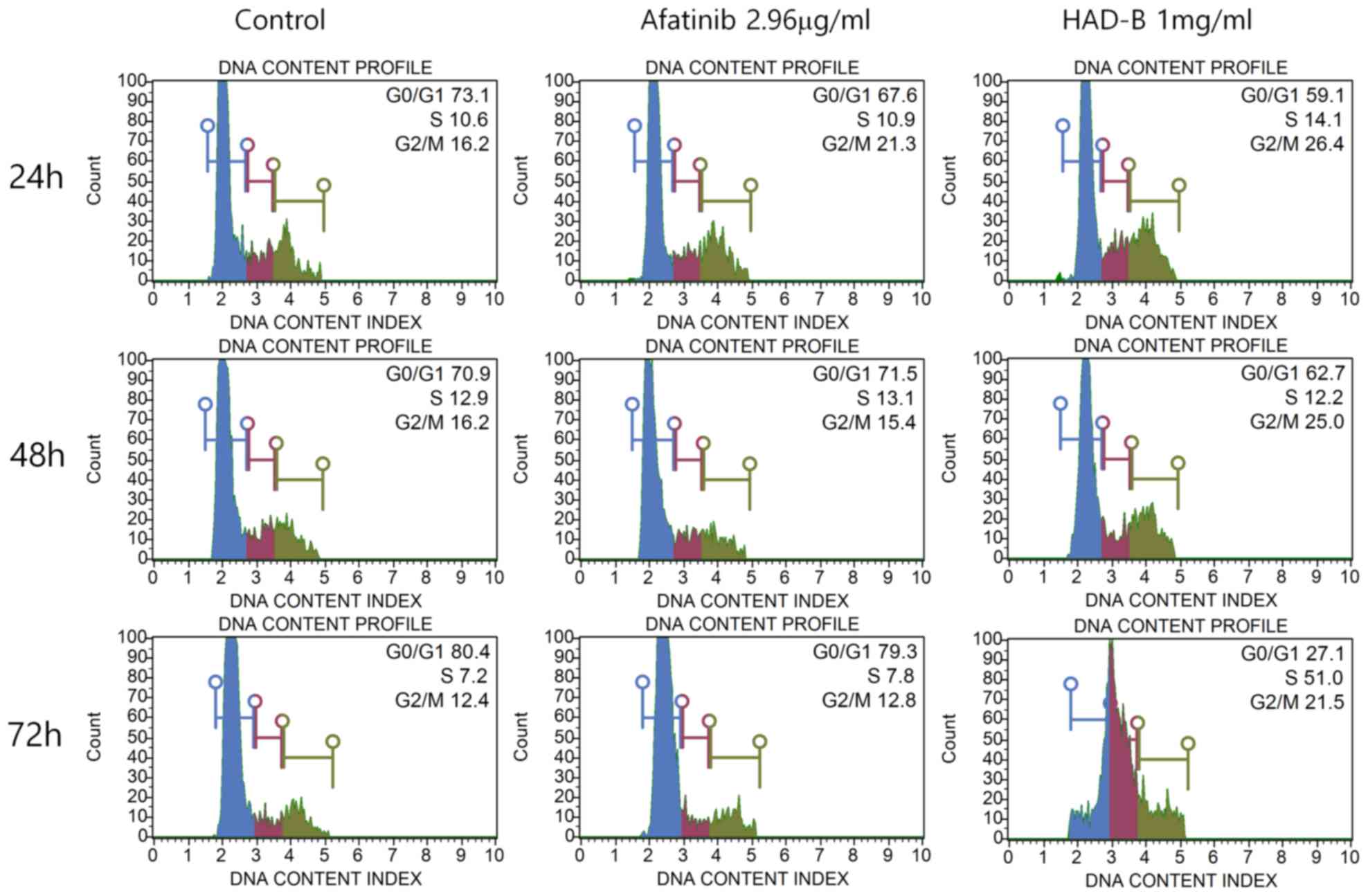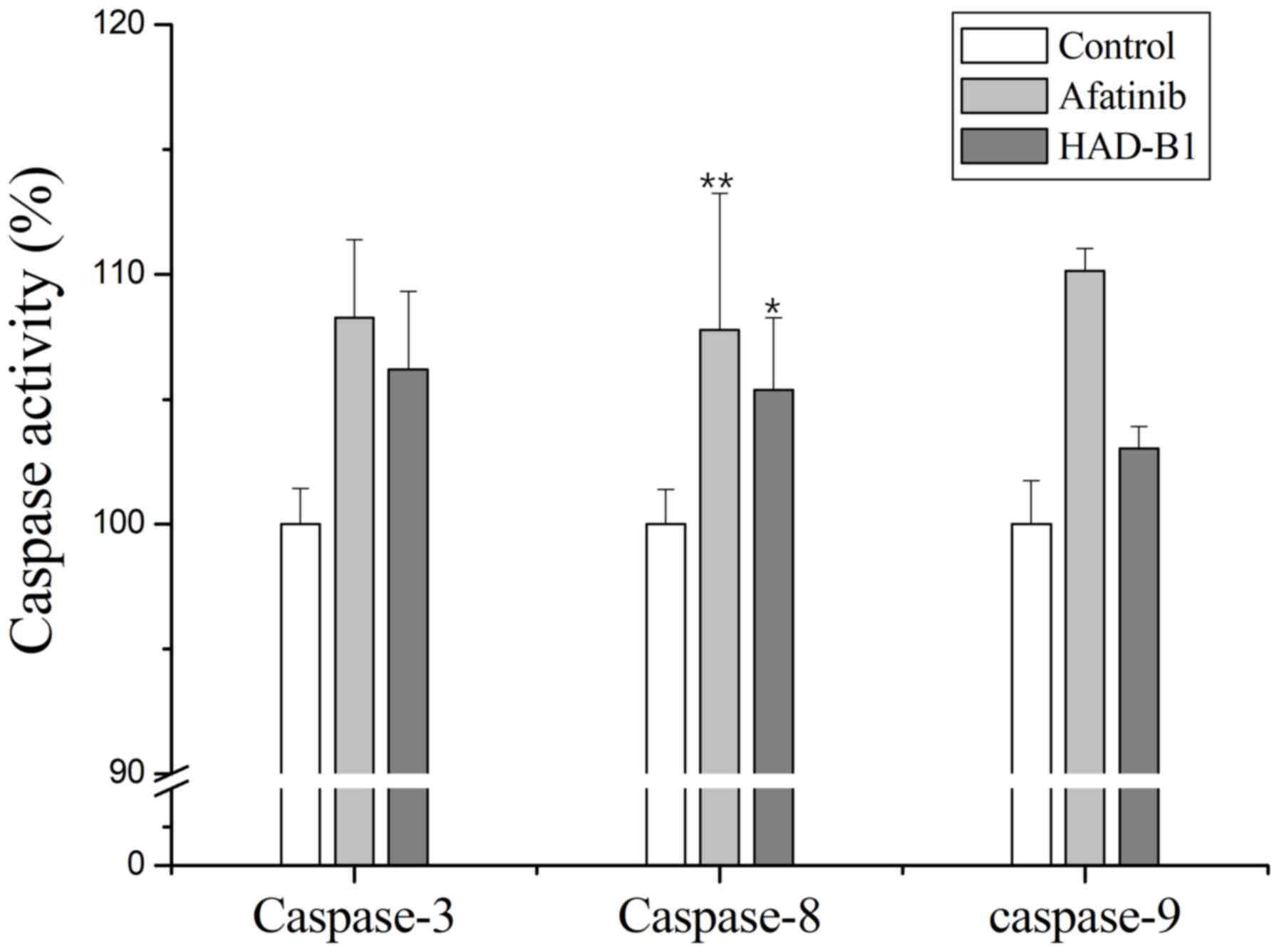Effects of HAD-B1 on the proliferation of A549 cisplatin-resistant lung cancer cells
- Authors:
- Published online on: March 7, 2018 https://doi.org/10.3892/mmr.2018.8702
- Pages: 6745-6751
Abstract
Introduction
Lung cancer has one of the highest disease-associated mortalities in the world (1). Currently, in the United States, cancer has the second highest mortality rate, and lung cancer has the highest rate of mortality in men and women (2). Non-small cell lung carcinoma (NSCLC) accounts for ~85% of lung cancer cases (3); treatment of NSCLC predominantly involves chemotherapy, radiation and surgery (4). Chemotherapy is currently the standard treatment for lung cancer (5) and cisplatin is widely used as an effective anti-cancer agent for the treatment of various types of malignant cancers (4). However, resistance to cisplatin has been observed, combined with toxicity to normal cells (6,7); thus, clinical cisplatin resistance (CR) is a major obstacle for the treatment of lung cancer (4).
HanAmDan-B1 (HAD-B1) is a blended herbal extract that is composed of Panax Notoginseng Radix, Cordyceps militaris, Panax ginseng C. A. Mey and Boswellia carterii Birdwood. HAD-B1 was modified from the previously developed HAD-B for use as an anti-cancer herbal medicine at the East West Cancer Center (EWCC; Dunsan Korean Medicine Hospital of Daejeon University, Daejeon, Korea) (8–10). A retrospective study of HAD-B indicated it may have efficacy in treating lung cancer (11–13) and it has been demonstrated to have an anti-angiogenesis effect on HUVEC cells (14). Furthermore, HAD-B exhibited a safe toxicological profile in normal cells (15).
This study was conducted to evaluate the anti-cancer effects of HAD-B1 against the lung cancer cell strain A549CR.
Materials and methods
Preparation of HAD-B1 extract
HAD-B1 was provided by the EWCC (Table I). A voucher specimen (#HAD-B-1-2014-10-HS) has been deposited at the Institute of Traditional Medicine and Bioscience in Daejeon University. The ingredients of the herb mixture (HAD-B1) were soaked for 18 h in a bath of distilled water at 60°C and the supernatant was obtained. The extracts were concentrated by using a rotary vacuum evaporator at 60°C for 2 h and were dried on a flat evaporator at 60°C for 8 h, the powder produced was used for the experiments (16). The HAD-B1 was dissolved in distilled water (DW).
Cell culture
A549 human lung cancer cells with CR were acquired from the ASAN Medical Center (Seoul, Korea). The cells were cultured in Dulbecco's modified Eagle's media (DMEM, Welgene, Inc., Daejeon, Korea) containing 10% fetal bovine serum (FBS, Welgene, Inc.) and 1X antibiotics (Welgene, Inc.). A549CR cell cultures were maintained at 37°C in a humidified atmosphere containing 5% CO2.
A549CR cell viability assay
A549CR cells (2×103 cells/well) were added to 96-well tissue culture plates and allowed to adhere overnight. HAD-B1, cisplatin, afatinib, and cordycepin were dissolved in distilled water. The cells were treated with HAD-B1 (0 and 4.8 µg/ml-20 mg/ml, 4 fold), cisplatin (0 and 0.01–30 µg/ml, 4 fold), afatinib (0 and 2.4 ng/ml-9.87 µg/ml, 4 fold), and cordycepin (0 and 0.012–200 µg/ml, 4 fold) and incubated for 72 h at 37°C. A total of 10 µl (5 mg/ml) MTT solution was added to each well, and the cells were incubated for 2 h at 37°C. The supernatants were discarded and the residual formazan crystals were dissolved in 100 µl dimethyl sulfoxide. The absorbance was measured at 595 nm on an Emax ELISA plate reader (Molecular Devices, LLC, Sunnyvale, CA, USA). Measurements were made in triplicate.
Apoptosis and cell cycle analysis
A549CR cells (1×106 cells/100 mm2 dish) were treated with HAD-B1 (1 mg/ml) for 24, 48 or 72 h at 37°C. Cell viability and apoptosis were determined using a Muse Annexin V & Dead Cell kit (EMD Millipore, Billerica, MA, USA) in accordance with the manufacturer's protocol. Cell cycle analysis was performed using a Muse Cell Cycle kit (EMD Millipore). Apoptosis and cell cycle were analyzed using Muse® Cell Analyzer (EMD Millipore).
Caspase activity assay
The enzyme activities of caspases-3 (BF3100), −8 (BF4100), and −9 (BF10100) in the cells were measured using kits purchased from R&D Systems, Inc. (Minneapolis, MN, USA). A549CR cells were collected using trypsin-EDTA following incubation with Afatinib (2.96 mg/ml) or HAD-B1 (1 mg/ml) for 72 h. Collected cells were centrifuged for 15 min at 582 × g and at room temperature, the supernatant was discarded, and the remaining cell pellet was incubated with Lysis-M solution (Roche Applied Science, Mannheim, Germany) on ice for 15 min. The lysed cells were centrifuged (15 min, 15,267 × g, 4°C), and the amount of protein in the supernatant was quantified using a Bradford assay kit (Bio-Rad Laboratories, Inc., Hercules, CA, USA). Protein lysates at a final concentration of 2 µg/µl) containing 0.1 M dithiothreitol were added into the wells of a 96-wellplate, 5 µl LEHD-pNA was added to each well and the plate was incubated at 37°C for 2 h. The absorbance was then measured at 405 nm using a microplate reader.
Protein extraction and fluorescence labeling of A549CR cells
A549CR cells were serum-starved by incubation in DMEM for 4 h. The cells were subsequently treated with or without HAD-B1 (1 mg/ml). Following incubation for 72 h, the cells were washed twice with phosphate-buffered saline (PBS), harvested using 5 mM EDTA-PBS and centrifuged for 15 min at 582 × g, at room temperature. The pellets were washed with PBS and centrifuged for 15 min at 582 × g, at room temperature. A549CR cells (5×105 cells/ml) were extracted using Lysis-M mammalian cell extraction buffer. Each protein extract (100 µg, 1 mg/ml) was separately labeled with Cyanine3 (Cy3) and Cyanine5 (Cy5; GE Healthcare Life Sciences, Little Chalfont, UK) according to the manufacturer's instructions. Free dyes were removed using Sigma Spin columns (S5059; Sigma-Aldrich; Merck KGaA, Darmstadt, Germany) and purified samples were stored at 4°C until use.
Preparation of InnoPharmaScreen (IPS) ProteoChip-based antibody microarray
Proteochip was provided from InnoPharmaScreen Inc. (Asan, Korea). Two chips were made with the same antibodies arrays. A total of 42 distinct antibodies against proteins involved in cell proliferation were spotted onto Proteochip arrays in duplicate (Fig. 1) (17).
Profile analysis of cell cycle proteins using IPS ProteoChip-based antibody microarray
The fluorescence-labeled cell lysates were applied to the antibody array and incubated for 1 h at 37°C in the dark. The slides were subsequently washed three times with PBS-0.1% Tween (PBST), dried until completely dry by N2 gas and analyzed using a fluorescence microarray scanner. Antibody array slides were scanned using a GenePix 4100A microarray scanner (Axon Instruments; Molecular Devices, LLC) with 532 and 635 nm lasers. Image analysis was performed for each spot using the manufacturer's software package (GenePix version 6.0; Axon Instruments; Molecular Devices, LLC). The internally normalized ratios (INR) of all spots were calculated using a previously described procedure (16,18).
Western blot analysis
A549CR cells were incubated with HAD-B1 (1 mg/ml) and Afatinib (2.96 µg/ml) in DMEM (containing 2% FBS and 1X antibiotics) for 72 h at 37°C. The cells were harvested to extract the proteins using Lysis-M buffer containing a protease and phosphatase inhibitor cocktail (Roche Applied Science) and clarified by centrifugation (15 min, 15,267 × g, 4°C). Lysates containing 40 µg protein were loaded into each well and separated by 12% sodium dodecyl sulfate-gel electrophoresis. Gels were subsequently soaked in transfer buffer (16 mM Tris-HCl, 30-mM glycine, 20% methanol) and proteins were transferred to polyvinylidene difluoride membranes. Nonspecific binding sites were blocked by incubation with 5% non-fat dried milk in PBST (137 mM NaCl, 27 mM KCl, 100 mM Na2HPO4, 20 mM KH2PO4 and 0.05% Tween-20, pH 7.4). The polyvinylidene difluoride membranes were then incubated with primary antibodies against signal transducer and activator of transcription 3 (STAT3; ab68153; 1:10,000; Abcam, Cambridge, UK), and β-actin (A5441; 1:10,000; Sigma-Aldrich; Merck KGaA) in PBST containing 5% non-fat skimmed milk (232100; BD Biosciences, Franklin Lakes, USA) at 4°C overnight. Membranes were washed with PBST and then incubated with secondary antibodies [Anti-Mouse IgG (Fc Specific); A0168; 1:10,000; Sigma-Aldrich; Merck KGaA and Anti-Rabbit IgG (whole molecule), A0545; 1:10,000; Sigma-Aldrich; Merck KGaA] for 1 h at room temperature. Signals were developed using an Enhanced chemiluminescence western blotting detection kit (EzWestLumi plus, WSE-7120S; ATTO Corporation, Tokyo, Japan) and blots were subsequently exposed to X-ray films (B2640, Agfa Gevaert NV, Mortsel, Belgium).
STAT3 knockdown and cell viability assay
Small interfering RNA (siRNA) of STAT3 (Human) was purchased from Bioneer Corporation, Daejeon, Korea (UGUUCUCUGAGACCCAUGA). Cells were transfected with STAT3 siRNA (100 nM) using Lipofectamine 2000 (11668,027; Invitrogen; Thermo Fisher Scientific, Inc., Waltham, MA, USA) for 24 h. Transfected cells were incubation in a 100 mm2 dish for 72 h and harvested to extract the proteins. The extraction was performed using western blotting. Transfection cells (2×103 cells/well) were incubated in a 96 well plate for 72 h and cell viability assayed using MTT assay.
Statistical analysis
All data are expressed as the mean ± standard deviation, and statistical comparisons were performed using a Student's t-test. Caspase activity data was compared using one-way analysis of variance with a post hoc Dunnett's test. Statistical analyses were performed using Microsoft Office Excel version 2007 (Microsoft Corporation, Redmond, WA, USA). P<0.05 was considered to indicate a statistically significant difference.
Results
Inhibitory effect of HAD-B1 on the viability of A549CR cells
To investigate the cytotoxic effect of HAD-B1 on A549CR cells, an MTT assay was employed. Cisplatin did not have a significant effect on cell viability; however, afatinib, a therapeutic agent targeted for NSCLC containing an epidermal growth factor receptor mutation, inhibited cell viability in a concentration-dependent manner (Fig. 2A and B). Notably, HAD-B1 significantly inhibited the growth of A549CR cells in a concentration-dependent manner; the half-maximal inhibition of A549CR cell growth by HAD-B1 was observed at a concentration of 0.41±0.05 mg/ml (Fig. 2C). Cordycepin, a major component of one of the ingredients in HAD-B1, Cordyceps militari, also inhibited the viability of A549CR cells in a concentration-dependent manner (Fig. 2D). This result demonstrated that HAD-B1 may have a suppressive effect on the growth of A549CR cells.
Profiling of expression proteins in A549CR cells treated with HAD-B1 using on antibody microarray
To investigate the molecular mechanism of HAD-B1 in A549CR cells, the cellsignaling protein expression profiles of HAD-B1-treated A549CR cells were investigated using an antibody microarray. Lysates from cells treated with HAD-B1 (1 mg/ml) or vehicle were labeled with a fluorescent dye (Cy5 or Cy3) and cross-reactivity of the two samples was performed on the antibody microarray (Fig. 1). The fluorescence intensity of each spot was measured using a fluorescence laser scanner and the protein expression pattern between the samples was determined. Based on the data analysis, HAD-B1 demonstrated the ability to decrease the expression of STAT3 in HAD-B1-treated cells (Fig. 3A and B).
Validation of antibody microarray-based protein profiling
To confirm the expression data from the profile analysis of cell cycle proteins in HAD-B1-treated A549CR cells, immunoblot analysis and an siRNA-based functional assay were employed. Downregulation of STAT3 was confirmed by western blotting (Fig. 3C). A549CR cells overexpressing STAT3 siRNA resulted in the downregulation of STAT3 at the protein level (Fig. 4A). STAT3 siRNA-transfected A549CR cells demonstrated a lower cell viability when compared with non-silencing siRNA (NS)-treated cells (Fig. 4B). This finding indicated that the negative effect of HAD-B1 on cell viability may be due to the downregulation of STAT3 in A549CR cells.
Cell cycle analysis and induction of apoptosis in HAD-B1-treated A549CR cells
To investigate whether the toxicity of HAD-B1 on A549CR cells was due to the induction of cell apoptosis and cell cycle arrest, a flow cytometric assay was employed. Cells were treated with HAD-B1 (1 mg/ml) for 24, 48 and 72 h. Induction of cell apoptosis was analyzed by Annexin-V/propidium iodide double staining using a Muse® Cell Analyzer. The early apoptotic rate was markedly increased in A549CR cells treated for 72 h, compared with the vehicle- and Afatinib-treated groups (Fig. 5). However, the early apoptotic rate of cells treated with HADB1 for 24 and 48 h was not altered. Cell cycle analysis was performed using a Muse® Cell cycle kit. The results indicated that S-phase arrest of the cell cycle was significantly increased in cells treated with HAD-B1 for 72 h, when compared with the vehicle-treated control group and the Afatinib-treated group (Fig. 6).
Activation of caspases in A549CR cells treated with HAD-B1
To further investigate the induction of apoptosis in A549CR cells treated with HAD-B1, an in vitro caspase activity assay was performed. Caspase-3, −8 and −9 were activated in A549CR cells treated with HAD-B1 (1 mg/ml) when compared with the control. This result indicated that HAD-B1 may enhance caspase activation, resulting in the induction of apoptosis (Fig. 7).
Discussion
Cisplatin is a commonly used chemotherapy agent; however, its limitations involve drug resistance and severe side effects (19). Due to the difficulty in treating cancer, many patients seek other therapies outside the field of formal medical care. These therapies are viewed as complementary and alternative, and the interest in such therapies is growing. According to European research, 35.9% of patients with cancer utilize alternative medicine, and 13.9% frequently use herbal medicines and natural products (20). In particular, interest in herbal medicines and natural medicinal products has been revealed to increase following the diagnosis of cancer; 13.3% of patients were reported to have used them at diagnosis, while only 5.3% used herbal medicines prior to diagnosis, an increase of ~3 fold (20). Therefore, the significance of employing natural products such as anti-cancer medications cannot be overlooked as vinca alkaloids, paclitaxel and epipodophyllotoxin, which, have been developed as anticancer agents, are composed of >60% natural products (21). HAD-B1 is composed of 4 natural products from different species of Korean medicinal plants. The present study focused on the effect of HAD-B1 on the lung cancer cell strain A549CR, which, is resistant to cisplatin, and the toxicity of HAD-B1 on A549CR cells was examined. Furthermore, using antibody microarray analysis in HAD-B1-treated A549CR cells, alterations to STAT3 expression were detected. Western blot analysis supported the microarray data, indicating that STAT3 was downregulated. The STAT3 protein is ubiquitously expressed in mammalian cells and has diverse functions during embryogenesis and early development (22). It is constitutively activated in a number of human cancer cells, and the downregulation or pharmacological inhibition of STAT3 are known to induce caspase-dependent cell death (22). The decrease of STAT3 activation leads to downregulation of Mcl-1 gene expression in cancer cells. When apoptotic signaling is triggered by TRAIL receptor, it proceeds through caspase-8-mediated Bid cleavage; the decrease of Mcl-1 protein level facilitates tBid-induced cytochrome c release from mitochondria and leads to caspase-9 activation that synergizes with caspase-8 to activate caspase-3 and PARP cleavage (23) Notably, Aplasia Ras homolog member I (ARHI) mediated blockade of STAT3 signaling arrested human ovarian cancer SKOV3 cells at S-Phase of the cell cycle, and induced apoptosis (24). The results of the present study indicated that the activities of caspase-3, −8 and −9 in the HAD-B1-treated group were increased. Furthermore, inhibition of cell viability, increased apoptosis and S-phase cell cycle arrest were also demonstrated. These results indicated that downregulation of STAT3 in A549CR cells treated with HAD-B1 resulted in S-phase cell cycle arrest and induction of caspase-mediated cell apoptosis.
In conclusion, HAD-B1 exhibited an anti-cancer effect against A549CR lung-cancer cells. The present study suggests that HAD-B1 has the potential to be a novel therapeutic agent for treating Cisplatin Resistant NSCLC. Further studies, including in vivo efficacy assay and mode-of-action, are required.
Acknowledgements
The present study was supported by the Daejeon University fund (grant no. 201501160001).
References
|
Siegel RL, Miller KD and Jemal A: Cancer Statistics, 2017. CA Cancer J Clin. 67:7–30. 2017. View Article : Google Scholar : PubMed/NCBI | |
|
Siegel RL, Miller KD and Jemal A: Cancer statistics, 2015. CA Cancer J Clin. 65:5–29. 2015. View Article : Google Scholar : PubMed/NCBI | |
|
Breathnach OS, Freidlin B, Conley B, Green MR, Johnson DH, Gandara DR, O'Connell M, Shepherd FA and Johnson BE: Twenty-two years of phase III trials for patients with advanced non-small-cell lung cancer: Sobering results. J Clin Oncol. 19:1734–1742. 2001. View Article : Google Scholar : PubMed/NCBI | |
|
Meng S, Zhou Z, Chen F, Kong X, Liu H, Jiang K, Liu W, Hu M, Zhang X, Ding C and Wu Y: Newcastle disease virus induces apoptosis in cisplatin-resistant human lung adenocarcinoma A549 cells in vitro and in vivo. Cancer Lett. 317:56–64. 2012. View Article : Google Scholar : PubMed/NCBI | |
|
National Comprehensive Cancer Network (NCCN): NCCN Clinical Practice Guidelines in Oncology (NCCN Guidelines®)Non-Small Cell Lung Cancer. NCCN; Fort Washington, PA: 2015 | |
|
Maroun JA, Anthony LB, Blais N, Burkes R, Dowden SD, Dranitsaris G, Samson B, Shah A, Thirlwell MP, Vincent MD and Wong R: Prevention and management of chemotherapy-induced diarrhea in patients with colorectal cancer: A consensus statement by the canadian working group on chemotherapy-induced diarrhea. Curr Oncol. 14:13–20. 2007. View Article : Google Scholar : PubMed/NCBI | |
|
de Gramont A, Figer A, Seymour M, Homerin M, Hmissi A, Cassidy J, Boni C, Cortes-Funes H, Cervantes A, Freyer G, et al: Leucovorin and fluorouracil with or without oxaliplatin as first-line treatment in advanced colorectal cancer. J Clin Oncol. 18:2938–2947. 2000. View Article : Google Scholar : PubMed/NCBI | |
|
Kim JM, Park JW, Yoo HS, Lee YW and Cho CK: Case report of the pancreatic cancer patient after pancreatoduodenectomy who is taking the hangam-plus to anti-metastasis and preventing recurrence. J Korean Tradit Onco. 16:33–39. 2011. | |
|
Kim KH, Park BR, Cho CK, Lee YW, Cho EJ, Yea SC, Yoo BC and Yoo HS: Proteome alteration in human colon cancer cells by the treatment of HangAmDan-B. Biochip J. 5:114–122. 2011. View Article : Google Scholar | |
|
Choi YJ, Shin DY, Lee YW, Cho CK, Kim GY, Kim WJ, Yoo HS and Choi YH: Inhibition of cell motility and invasion by HangAmDan-B in NCI-H460 human non-small cell lung cancer cells. Oncol Rep. 26:1601–1608. 2011.PubMed/NCBI | |
|
Zheng HM, Yoon JW, Lee YW, Cho CK, Oh DS and Yoo HS: Case series of advanced non-small cell lung cancer patients treated with Hang-Am Plus. Korean J Orient Int Med. 32:113–120. 2011. | |
|
Kim KS, Jung TY, Yoo HS, Lee YW and Cho CK: Case series of advanced non-small cell lung cancer patients treated with Hang-Am-Plus. Korean J Orient Int Med. 30:893–900. 2009. | |
|
Park BK, Yoo HS, Lee YW, Han SS, Cho JH, Son CG and Cho CK: Retrospective cohort analysis for lung cancer patients treated with Wheel Balance Therapy (WBT). Korean J Orient Int Med. 29:45–56. 2008. | |
|
Bang JY, Kim EY, Yoo HS, Lee YW, Kim YS, Cho CK, Choi Y, Jeong HJ and Kang IC: Analysis of anti-angiogenic mechanism of HangAmDan-B (HAD-B), a Korean traditional medicine, using antibody microarray chip. BioChip J. 4:350–355. 2010. View Article : Google Scholar | |
|
Yoo HS, Lee HJ, Kim JS, Yoon J, Lee GH, Lee YW and Cho CK: A toxicological study of HangAmDan-B in mice. J Acupunct Meridian Stud. 4:54–60. 2011. View Article : Google Scholar : PubMed/NCBI | |
|
Kang HJ, Park SJ, Park YM, Yoo HS and Kang IC: Inhibitory effects of HangAmDan-B1 (HAD-B1) on A549 lung cancer cell proliferation and tumor growth in a xenograft model. Acad J Sci Res. 4:187–193. 2016. | |
|
Bang JY, Kim EY, Kang DK, Chang SI, Han MH, Baek KH and Kang IC: Pharmacoproteomic Analysis of a Novel Cell-permeable Peptide Inhibitor of Tumor-induced Angiogenesis. Mol Cell Proteomics. 10:M110.0052642011. View Article : Google Scholar : PubMed/NCBI | |
|
Fumagalli S, Totty NF, Hsuan JJ and Courtneidge SA: A target for Src in mitosis. Nature. 368:871–874. 1994. View Article : Google Scholar : PubMed/NCBI | |
|
Galluzzi L, Senovilla L, Vitale I, Michels J, Martins I, Kepp O, Castedo M and Kroemer G: Molecular mechanisms of cisplatin resistance. Oncogene. 31:1869–1883. 2012. View Article : Google Scholar : PubMed/NCBI | |
|
Molassiotis A, Fernadez-Ortega P, Pub D, Ozden G, Scott JA, Panteli V, Margulies A, Browall M, Magri M, Selvekerova S, et al: Use of complementary and alternative medicine in cancer patients: A European survey. Ann Oncol. 16:655–663. 2005. View Article : Google Scholar : PubMed/NCBI | |
|
Cragg GM and Newman DJ: Plants as a source of anti-cancer agents. J Ethnopharma. 100:72–79. 2005. View Article : Google Scholar | |
|
Aoki Y, Feldman GM and Tosato G: Inhibition of STAT3 signaling induces apoptosis and decreases survivin expression in primary effusion lymphoma. Blood. 101:1535–1542. 2003. View Article : Google Scholar : PubMed/NCBI | |
|
Lirdprapamongkol K, Sakurai H, Abdelhamed S, Yokoyama S, Athikomkulchai S, Viriyaroj A, Awale S, Ruchirawat S, Svasti J and Saiki I: Chrysin overcomes TRAIL resistance of cancer cells through Mcl-1 downregulation by inhibiting STAT3 phosphorylation. Int J Oncol. 43:329–337. 2013. View Article : Google Scholar : PubMed/NCBI | |
|
Zhu Q, Hu J, Meng H, Shen Y, Zhou J and Zhu Z: S-Phase cell cycle arrest, apoptosis, and molecular mechanisms of aplasia ras homolog member i-induced human ovarian cancer SKOV3 cell lines. Int J Gynecol Cancer. 24:629–634. 2014. View Article : Google Scholar : PubMed/NCBI |



